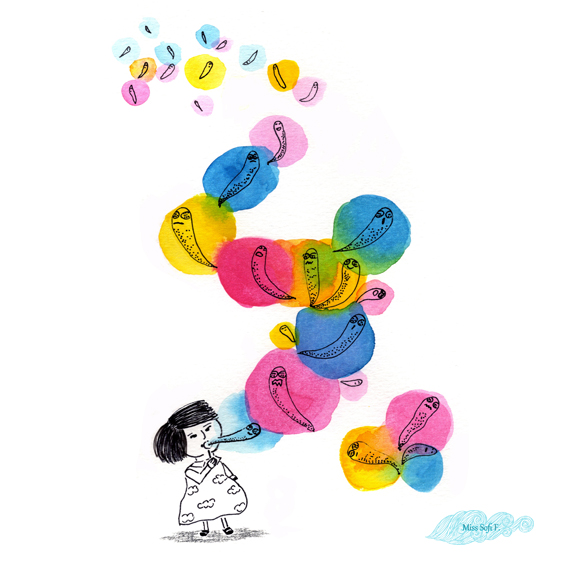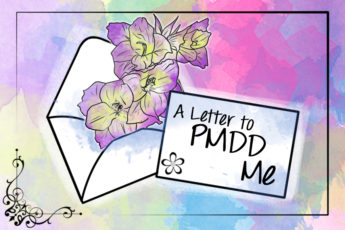By Sofia Fortunato
The bed feels like quicksand. I can’t get out. I sink deep. The smell of fresh coffee drifts in the air. He is making me coffee. I curl my body to the side. I hide under my bedsheet. I know it is time to get up, but I feel weak. The bed feels like quicksand. My body feels heavy. I sink deeper. My head and nostrils ache. I struggle. I can’t get out. When I finally escape, I drag my feet to the kitchen. My body feels heavy.
My partner offers me coffee. “Good morning, honeybunch,” he says. I roll my eyes, grab my coffee, and growl like an ogre. In the meantime, my children wake up. I can hear them screaming. I storm outside the veranda to avoid them. I can’t stand the noise. I feel overwhelmed. When I sit on my comfy outdoor chair, I sip my coffee, I sniff the fresh air. A green garden full of tropical plants stands in front of me. A honey bird comes to visit the red ginger flower next to me. I put the coffee on the side table. I sigh. My hands cover my face as tears stream down. Why do I feel so miserable if I have a perfect life? “Just look around you. You have it all,” I say to myself.
The situation I described above, it wasn’t fictional. Ever since my twenty’s, Miss Depression visits in the mornings. However, at the age of 35, Miss Depression brought with her some undesired friends: Mister Sudden Rage, Mister Panic Attack, Miss Anxiety, Dr. Migraines, Mister Misophonia, and Miss Tiredness.
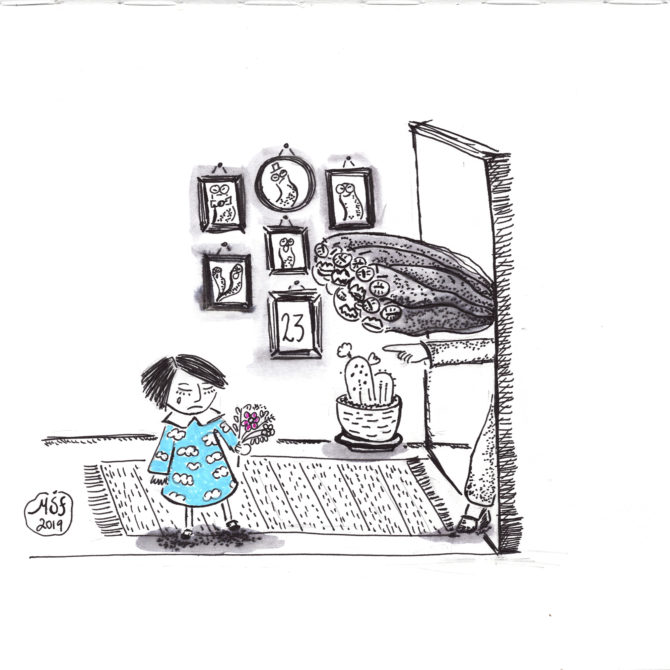
For a long time, I didn’t notice that my undesired friends would visit in a pattern. They invaded my head and my life. They made me feel unstable, unbalanced, and crazy. They drowned me in an ocean of emotions, emotions I couldn’t understand. Some days, I wanted to hide in a closet because I couldn’t stand my children’s noises. Some days, not even my favorite music would feel pleasant to hear. Other times, I avoided people altogether. I knew something was wrong with me, but my doctor couldn’t figure out what. Eventually, in 2017, after recording all my symptoms in a journal for a year, and after seeing a new doctor, I was diagnosed with premenstrual dysphoric disorder, PMDD, for short. I decided then to embrace PMDD without medication. I knew that if I wanted to survive, I needed to learn first how to control and tame my mood changes during PMDD. Finding a way hasn’t been easy. But I can pat my back with pride because I have managed to survive. And in between my battle, I even managed to find the bright side of PMDD for me.
After two years, I’ve decided to share how I’ve done it. These tips worked for me, but I know your situation is probably completely different than mine. However, I hope that within these lines, you can feel inspired and somehow find a light around your PMDD too.
Tip 1: I keep track of everything.
Three years ago, I downloaded a menstrual cycle app and purchased a notebook. Since then, I take them with me wherever I go. I use both to carefully record all my symptoms and mood changes. With this information on hand, I know which days are worst for me. So when the mood changes come, I know it is a product of my menstrual cycle. To control my emotions, I avoid certain situations in life that can trigger those undesired feelings, which brings me to Tip 2.
Tip 2: I plan before it hits me.
For me, the worst days are between days 12 and 15 of my menstrual cycle. So, before and during, I don’t plan any important meetings or events that might trigger extra stress or anxiety. Let’s put it in other words, I try not to do things that might exacerbate my emotions during my worst PMDD days.
Tip 3: I go into Slow Mode.
I also avoid working too much or overloading my head with a long to-do list. I have found that an excessive workload makes my symptoms worse. So during PMDD days, take-it-easy and slow-down, are my modes. If I succeed at planning well for a given month, I don’t end up feeling that bad, and the migraines aren’t as intense.
Tip 4: I avoid social media.
I have learned the hard way that I must avoid social media during PMDD days. I have canceled two Twitter, one Facebook, and two Instagram accounts in the last two years. And yes, you probably guessed it, I did it all during my PMDD days. I recognized that certain posts on social media could trigger negative feelings for me. I have decided to avoid social media and switch the world off for a couple of days. This, in turn, has brought more positives to my life because I’ve had to find something else to focus on, which takes me to tip 5.
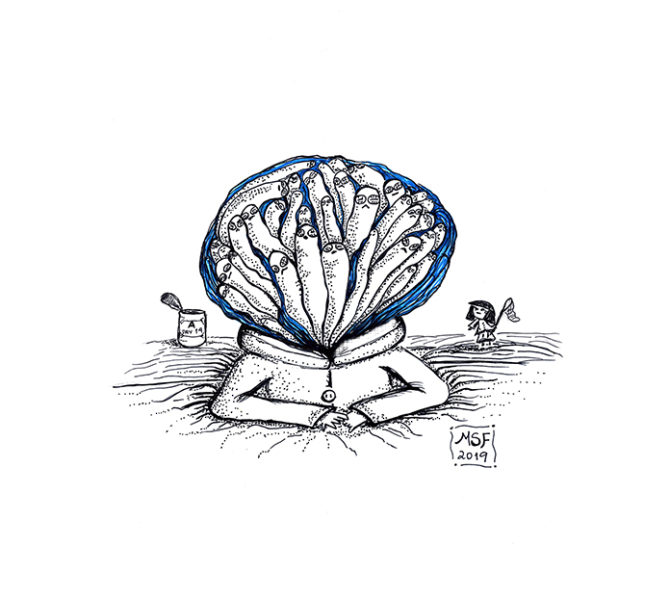
Tip 5: I keep art at my side.
I permit myself to have a break from life during PMDD days. And when possible, I take two to three days off from work when I need it. But, I don’t sit around doing nothing because that brings the risk of filling my head with self-damaging thoughts. Instead, I try to do any healthy activity that nurtures my mind and gives me satisfaction. If I do this, I find it easy to battle the emotions. Learning an art skill during the days has worked wonderfully for me. For instance, I have found that PMDD triggers my creative side. It is almost as if PMDD makes my skin thinner because I can feel the world differently. Maybe it is because I feel very emotional. I have turned those emotions into a source of artistic inspiration. This eventually turned into an art project which I called Maret, the marerits and me (IG @mareritina). So, are you a creative person? I think we all are. You might try to embrace a creative project during those days. Don’t choose something too challenging, something that would make you feel tired and overwhelmed, which in consequence could make your PMDD symptoms worse. Find something enjoyable. Buy a white canvas, paint, and some brushes. Try to paint. Or are you into quilting, knitting, or pottery? Give it a go!
Tip 6: I read
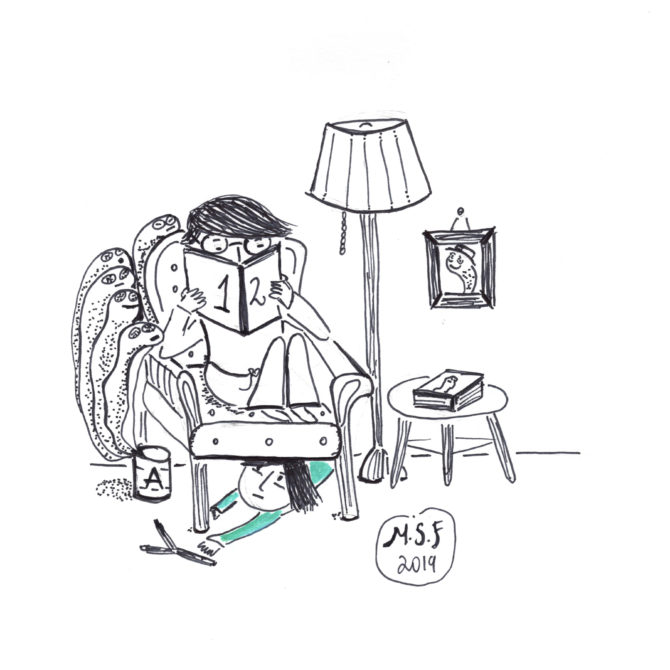
It also helps when I read during PMDD days. If I feel like reading, then I find a nice spot and allow myself to have a long reading session. Then, If I submerge my head in someone else’s story, I feel somehow better. Children’s books, non-fiction books about learning an art skill, or books on history work very well for me. A side note here, if PMDD makes you vulnerable and more prone to crying, then avoid books with sad stories or that can reflect on your life.
Tip 7: I exercise
Research has shown that releasing adrenaline into our system while exercising can help to improve PMDD symptoms. Whatever is your favorite exercise, do it during your bad days. So, during PMDD days I go for a walk, or swim a lot! You are probably thinking, how? If I can’t get out of my bed. Yes, I hear you. I feel the same way. How do I exercise, when the only thing I want to do is to stay all day in bed during PMDD days? Well, this brings me to the next tip.
Tip 8: I educate my family and friends about PMDD.
Before I found out I had PMDD, my partner used to get very frustrated at me. I don’t think he was very fond of my lack of interest in life some mornings. It was hard to deal with him – and I had already enough trouble dealing with myself. Once I discovered I had PMDD, I talked to him, I explained what it was with scientific facts. That has made a huge difference in our relationship. Now, the days I feel bad, he forces me out of bed, and even out of the house. I always refuse, but he manages to take me out for a walk. And then, after I return, I feel better, and I even manage to cope with the rest of the day. I am glad to have him. He helps me with my battles and struggles.
But if you live alone, what about getting a dog? Dogs need to go for a walk, right? So perhaps that could work for you. Or, if not, then tell someone in your family or a friend to pick you up and take you out. Let them know which days and plan a short walk in the morning before they go to work. If they love you, they will do this for you. Or if they are busy, tell them to give you a phone call while you walk.
Tip 9: I eliminate other possible triggers.
I used to work as a researcher at a University. I loved my career. I was living the path I once dreamt of when I was a Uni student. I made it a long way, and I was proud of it. However, during my days as a researcher, the panic attacks were constant, the anxiety was terrifying, and the migraines mortifying. It started affecting my life at home too. I was too exhausted to have time for my children. My rage attacks were shocking. At some points, I couldn’t recognize myself. I had suspicions that the workload of academic life was making my symptoms worse. After journaling my symptoms and emotions for a year, I realized it sure was.
One day, after the last panic attack I had at work, I made the tough decision of leaving my career path for a while to reconnect with myself again. The decision to leave, while very difficult, has certainly improved my health. So, in summary, try to think if there is something in your life that is worsening your PMDD symptoms. Can you do something about it? List all those things that frustrate you the most when you are on PMDD. Perhaps, you work too much, can you work a bit less? Maybe it is not as drastic as what I did, but it could be something that you need to take out of the equation.
The bright side of PMDD
Knowing that I have PMDD has been positive. If I didn’t know it was affecting me, I wouldn’t have rediscovered my artistic side. If I hadn’t chosen to leave my career to reconnect with myself, I wouldn’t have gained a new lifestyle. After discovering I had PMDD, I have tried other adventures. I found a new job that suits me better and gives me time to rest. Most important of all, I feel now that on PMDD days, I reset my body every month. I slow down and reconnect with myself. I even read and exercise more. Does that sound like PMDD could be something positive?
Even when PMDD makes me feel an infinite sadness, I try to let it be; I cry it out and write it all down. I let go. I have learned to control and tame the self-damaging talk inside my head during PMDD days. I have learned to carefully grab every single thought from my head, write it down, and wait for a couple of days. Most importantly, I don’t let the thoughts take over my life. On day seventeen, when everything goes back to normal, the self-damaging thoughts just stay inside a notebook, trapped within words, not my head.
About the Warrior
Sofia Fortunato
I am originally from Venezuela. I currently live in Australia, in a tropical paradise called Airlie beach. I am a creative artist and swimming teacher, with a degree in Biology. I am the creator of Outdoor-hobbits. I love to write and illustrate children’s books. I also paint and have an online art shop.
Website | Instagram – @mareritina @misssofif_art | Facebook | Twitter

